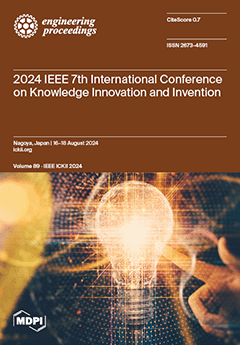Eng. Proc., 2025, IEEE ICKII 2024
2024 IEEE 7th International Conference on Knowledge Innovation and Invention
Nagoya, Japan | 16–18 August 2024
Volume Editors:
Teen-Hang Meen, National Formosa University, Yunlin, Taiwan
Chun-Yen Chang, National Taiwan Normal University, Taipei, Taiwan
Cheng-Fu Yang, National University of Kaohsiung, Kaohsiung, Taiwan
Printed Edition Available!
- Issues are regarded as officially published after their release is announced to the table of contents alert mailing list.
- You may sign up for e-mail alerts to receive table of contents of newly released issues.
- PDF is the official format for papers published in both, html and pdf forms. To view the papers in pdf format, click on the "PDF Full-text" link, and use the free Adobe Reader to open them.




